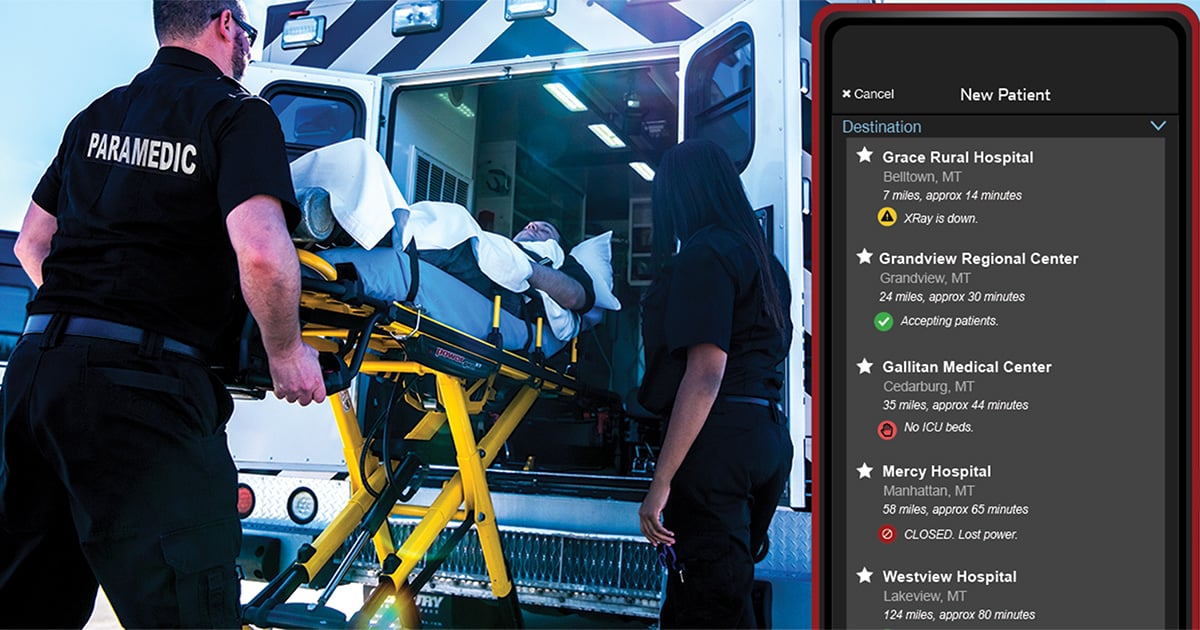Does Your Team Feel Unseen? Close the Leadership Disconnect with 2-Way Communication
Editor's Note: In July 2025, EMS1 and Fitch & Associates released their annual EMS trend survey, What Paramedics Want, proudly sponsored by Pulsara....

Time-sensitive emergencies are demanding events. Rapid response, coordinated teams, and extensive resources are crucial for patients whose conditions deteriorate quickly. Whether it's a STEMI, stroke, trauma incident—or even a mass casualty incident like a hurricane or multi vehicle accident—treatment time is often a dominant factor when determining the post-treatment wellbeing of a patient.
Cutting down treatment times by just minutes can have life-changing positive impacts for patients, which is why time-sensitive emergencies are a significant point of focus for both hospitals and EMS. Communication technology can make time-sensitive care more efficient, improving provider workflows and patient outcomes.
First responders spend a lot of time assessing patients and entering preliminary information into their ePCR system. While it may seem like a brief point in the ambulance-to-ED journey, cutting down documentation time allows EMS teams to spend more time coordinating with the hospital and caring for the patient.
With Pulsara, emergency caregivers can open a new patient channel, use their smartphone’s camera to scan the patient’s driver’s license, and populate patient information fields instantly. With integrations with most major ePCR systems, the need for double documentation is eliminated.
The hospital-wide game of telephone (and paging) not only takes up time, but increases the chances of costly miscommunications. By utilizing Pulsara’s “single source of truth” platform, all activated team members can instantly share and access essential patient data including vitals, photos, and activities documented by EMS. Without the need to run information through radio and multiple staff members, EMS also becomes a part of the central care team, participating in secure, multi-way communication.
Pulsara offers HIPAA-compliant text messaging as well as live audio/video conference calls. Hospital staff can directly ask EMS questions while they're still en route, rounding out critical case information for accurate preparation.

During mass casualty incidents (MCIs), traditional communication and documentation systems are quickly overwhelmed. Multiple patients arriving simultaneously from multiple locations can lead to confusion, lost information, and duplicated efforts. Pulsara supports emergency wristband systems used across regions, allowing first responders and care teams to scan a wristband to automatically create or join a patient channel.
Each patient’s information, status, and location can be tracked in real time across agencies and facilities. For large-scale events involving multiple patients, Pulsara’s platform helps incident command maintain situational awareness, ensure patients aren’t missed or mixed up, and track care decisions even as patients are transported across jurisdictions.
Early notification is one of the most powerful tools in shortening treatment times. With Pulsara, EMS can notify the hospital of a time-sensitive case from the field with a simple tap. The patient channel includes vital signs, condition updates, ECG images, photos, and notes—all shared instantly and securely.
This advance information allows the hospital to prepare the right teams and equipment in real time. Stroke and STEMI alerts can be reviewed by neurologists or cardiologists before the patient even arrives, reducing time to intervention. During time-sensitive emergencies, having a prepared ER, cath lab, or operating room can be one of the most significant improvements to patient treatment times.
Without Pulsara, EMS would typically use a radio report to inform the ED of incoming patients and their acuity level. Afterward, hospital staff would use phone calls, pagers, emails, and word of mouth to prepare resources for time-sensitive cases. Once activated, it takes time to get the nurses, physicians, and specialists organized and on the same page.
When a Pulsara alert is received and acknowledged by an ED employee, assembling the care team happens in just a few clicks on a mobile device or desktop. Selected staff members, whether on duty or on call, are instantly alerted by the Pulsara app and added to the case. Teams can communicate, gather, and make key preparations before the patient arrives. To hear more about the impact of on-the-fly team assembly, check out this customer testimonial.

When EMS and hospitals share one communication platform, it opens up the opportunity for pre-hospital diagnosis of time-sensitive cases like STEMI and stroke. Alerted hospitals can add cardiologists, neurologists, and other specialists to the care team, sharing important monitor data and symptom information recorded by EMS. These specialists can ask clarifying questions while the ambulance is en route and assemble their teams on the fly.
When the patient arrives, rather than waiting at the ED or getting reassessed by a physician, they can be taken directly to specialized treatment in the cath lab or operating room. Significant reductions in treatment times for every time-sensitive case are possible when prehospital preparation is optimized.
Patient handoffs are a frequent source of miscommunication, especially in emergencies. Details shared verbally can be incomplete or misheard, leading to delays or redundant assessments. Pulsara improves handoffs by preserving a clear, chronological record of care—from the first EMS interaction through hospital treatment.
All care team members can access the same data: photos, notes, timestamps, and assessments. This continuity ensures no time is wasted repeating information and that each new provider can pick up exactly where the last one left off. For interfacility transfers, the same patient channel can continue across systems, maintaining visibility and documentation from scene to specialty center.

Before cardiac patients can get the urgent treatment they need, their ECG readings need to be shared with the hospital and evaluated by a qualified physician or cardiologist. Prior to integrated solutions, monitor data was often sent to hospitals via fax, printed out, and shown physically to doctors and nurses, adding costly minutes to the diagnosis and treatment process.
Pulsara has integrations with major monitor producers like Zoll and Philips to enable streamlined functionality. When using a monitor integrated with Pulsara, ECG readings can be uploaded instantly into the patient channel in Pulsara. If EMS’s cardiac monitor has not yet integrated with Pulsara, the platform’s secure photo feature can add an image of the ECG to the channel just as easily. By sharing data directly with downstream members of the care team, EMS teams are met with prepared EDs and speedy treatment for their patients. Learn more about Pulsara’s integrations with the industry’s leading ePCRs, cardiac monitors, and stroke diagnostic software here.
Coordinating multiple patients, teams, and agencies during disasters or MCIs requires a shared operational picture. Pulsara’s Incident Management capabilities include a dashboard view where administrators and medical command can monitor active cases, locations, and team responses across an entire region or event.
The dashboard offers real-time insights into patient statuses, response timelines, and facility readiness. This level of coordination empowers leaders to make informed decisions, allocate resources dynamically, and ensure the best outcomes even in chaotic, high-pressure scenarios.
Accurate documentation is essential for patient care, billing, and quality improvement—but in an emergency, it can be difficult to keep up. Pulsara automatically timestamps every action in the patient channel, from the first alert to the final disposition. These digital records reduce the burden on clinicians to manually track events and ensure that nothing is missed.
Whether it's confirming door-to-balloon times or reconstructing response workflows for performance review, Pulsara’s real-time documentation and post-case summary reports create a reliable, auditable source of truth. And because the channel is accessible to the full care team, it supports accountability, compliance, and ongoing improvement in emergency care delivery.
These time-saving techniques aren’t just theory—they are a reality for healthcare systems that choose Pulsara. Across all patient types, systems using Pulsara see reductions to average treatment times between 22% and 68%. For time-sensitive emergencies, Pulsara has helped organizations make significant strides in key metrics, including:
![]()
Building muscle memory eases stress during critical emergencies. That's where using the same tools everyday, regardless of event, can be so powerful. Check out 10 Benefits of Using the Same Communication Tool Every Day to learn more.

Editor's Note: In July 2025, EMS1 and Fitch & Associates released their annual EMS trend survey, What Paramedics Want, proudly sponsored by Pulsara....
![[PRESS RELEASE] Published Research Finds Up to 31% Faster STEMI Treatment Times in Rural Hospital Setting with Pulsara](https://www.pulsara.com/hubfs/_1_website-page-blog-assets/pulsara-hosp-teams-assign-cardio-stemi-rn-1200x701.jpg)
Published research shows how using Pulsara, alongside standardized field activation and a focus on stakeholder relationships, improves STEMI care and...

Editor's Note: In July 2025, EMS1 and Fitch & Associates released their annual EMS trend survey, What Paramedics Want, proudly sponsored by Pulsara....